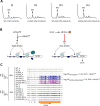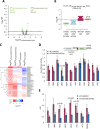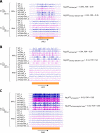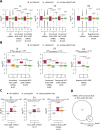This is a preprint.
Yeast eIF2A has a minimal role in translation initiation and uORF-mediated translational control in vivo
- PMID: 37986989
- PMCID: PMC10659434
- DOI: 10.1101/2023.10.06.561292
Yeast eIF2A has a minimal role in translation initiation and uORF-mediated translational control in vivo
Update in
- This article has been published with doi: 10.7554/eLife.92916.3
-
Yeast eIF2A has a minimal role in translation initiation and uORF-mediated translational control in vivo.Elife. 2024 Jan 24;12:RP92916. doi: 10.7554/eLife.92916. Elife. 2024. PMID: 38266075 Free PMC article.
Abstract
Initiating translation of most eukaryotic mRNAs depends on recruitment of methionyl initiator tRNA (Met-tRNAi) in a ternary complex (TC) with GTP-bound eukaryotic initiation factor 2 (eIF2) to the small (40S) ribosomal subunit, forming a 43S preinitiation complex (PIC) that attaches to the mRNA and scans the 5'-untranslated region (5' UTR) for an AUG start codon. Previous studies have implicated mammalian eIF2A in GTP-independent binding of Met-tRNAi to the 40S subunit and its recruitment to specialized mRNAs that do not require scanning, and in initiation at non-AUG start codons, when eIF2 function is attenuated by phosphorylation of its α-subunit during stress. The role of eIF2A in translation in vivo is poorly understood however, and it was unknown whether the conserved ortholog in budding yeast can functionally substitute for eIF2. We performed ribosome profiling of a yeast deletion mutant lacking eIF2A and isogenic wild-type (WT) cells in the presence or absence of eIF2α phosphorylation induced by starvation for amino acids isoleucine and valine. Whereas starvation of WT confers changes in translational efficiencies (TEs) of hundreds of mRNAs, the eIF2AΔ mutation conferred no significant TE reductions for any mRNAs in non-starved cells, and it reduced the TEs of only a small number of transcripts in starved cells containing phosphorylated eIF2α. We found no evidence that eliminating eIF2A altered the translation of mRNAs containing putative IRES elements, or harboring uORFs initiated by AUG or near-cognate start codons, in non-starved or starved cells. Thus, very few mRNAs (possibly only one) appear to employ eIF2A for Met-tRNAi recruitment in yeast cells, even when eIF2 function is attenuated by stress.
Figures







Similar articles
-
Yeast eIF2A has a minimal role in translation initiation and uORF-mediated translational control in vivo.Elife. 2024 Jan 24;12:RP92916. doi: 10.7554/eLife.92916. Elife. 2024. PMID: 38266075 Free PMC article.
-
eIF1 Loop 2 interactions with Met-tRNAi control the accuracy of start codon selection by the scanning preinitiation complex.Proc Natl Acad Sci U S A. 2018 May 1;115(18):E4159-E4168. doi: 10.1073/pnas.1800938115. Epub 2018 Apr 16. Proc Natl Acad Sci U S A. 2018. PMID: 29666249 Free PMC article.
-
The eIF2A knockout mouse.Cell Cycle. 2016 Nov 16;15(22):3115-3120. doi: 10.1080/15384101.2016.1237324. Epub 2016 Sep 29. Cell Cycle. 2016. PMID: 27686860 Free PMC article.
-
A Retrospective on eIF2A-and Not the Alpha Subunit of eIF2.Int J Mol Sci. 2020 Mar 17;21(6):2054. doi: 10.3390/ijms21062054. Int J Mol Sci. 2020. PMID: 32192132 Free PMC article. Review.
-
Structural Insights into the Mechanism of Scanning and Start Codon Recognition in Eukaryotic Translation Initiation.Trends Biochem Sci. 2017 Aug;42(8):589-611. doi: 10.1016/j.tibs.2017.03.004. Epub 2017 Apr 22. Trends Biochem Sci. 2017. PMID: 28442192 Review.
References
-
- Adams SL, Safer B, Anderson WF, Merrick WC. 1975. Eukaryotic initiation complex formation. Evidence for two distinct pathways. J Biol Chem 250: 9083–9089. - PubMed
Publication types
LinkOut - more resources
Full Text Sources
Research Materials
Miscellaneous
